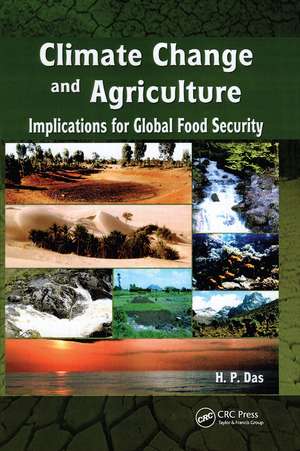Climate Change and Agriculture: Implication for Global Food Security
Autor H.P. Dasen Limba Engleză Hardback – 21 mar 2016
Preț: 998.74 lei
Preț vechi: 1373.49 lei
-27% Nou
Puncte Express: 1498
Preț estimativ în valută:
191.11€ • 208.24$ • 161.04£
191.11€ • 208.24$ • 161.04£
Comandă specială
Livrare economică 02-16 aprilie
Doresc să fiu notificat când acest titlu va fi disponibil:
Se trimite...
Preluare comenzi: 021 569.72.76
Specificații
ISBN-13: 9781498769761
ISBN-10: 1498769764
Pagini: 615
Dimensiuni: 159 x 241 x 41 mm
Greutate: 1.11 kg
Ediția:1
Editura: The Book Syndicate
Colecția CRC Press
ISBN-10: 1498769764
Pagini: 615
Dimensiuni: 159 x 241 x 41 mm
Greutate: 1.11 kg
Ediția:1
Editura: The Book Syndicate
Colecția CRC Press
Public țintă
Academic and Professional ReferenceCuprins
Climate Change and Agriculture
Notă biografică
Dr. H.P. Das, former Deputy Director General of Meteorology of the India Meteorological Department, was in-charge of the Division of Agricultural Meteorology, Pune and in that capacity had been implementing the operational and research programmes of the Division. He has actively participated in many Agricultural Meteorology Programmes of the World Meteorological Organization (WMO) as Chairman/Leader/Member of several Working Groups and Expert Teams of the WMO Commission for Agricultural Meteorology. With over 35 years of experience in agrometeorological research and applications and teaching in various aspects of Agricultural Meteorology, Dr. Das has authored over 175 research papers and articles, as well as many book chapters and several other technical publications including WMO Technical Notes and Training materials. He is a recipient of the award of the WMO Commission for Agricultural Meteorology for his outstanding contributions and exceptional service to the commission. He is currently the Vice-President of the International Society for Agricultural Meteorology (INSAM).
Descriere
This book represents a major step in understanding the science of various aspects of climate change with likely impacts on agriculture, livestock, forestry, and fisheries. It provides clear adaptation strategies required to reduce their vulnerability.
